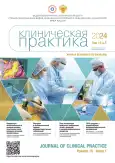“Blind spots” in the analysis of computed tomography of the head and neck area
- Authors: Nechaev V.A.1, Vasiliev A.Y.2,3
-
Affiliations:
- Moscow City Hospital named after S.S. Yudin, Moscow Healthcare Department
- Russian University of Medicine
- Central Research Institute of Radiological Diagnostics
- Issue: Vol 15, No 1 (2024)
- Pages: 66-74
- Section: Original Study Articles
- URL: https://journals.rcsi.science/clinpractice/article/view/257931
- DOI: https://doi.org/10.17816/clinpract624757
- ID: 257931
Cite item
Full Text
Abstract
BACKGROUND: Diagnostic errors in radiology occur in 2–5% of cases and most of them are due to perception errors, when a pathological change is not detected during the initial analysis, although its presence is very obvious during a retrospective analysis. In some cases, the errors appear due to the presence of «blind spots» — anatomical areas that most often go unnoticed when interpreted by a radiologist. It is extremely important to know their features when analyzing the CT study of the head and neck area for a targeted and systematic search for pathology.
AIM: To determine the most common anatomical areas in which radiologists frequently miss pathological changes when analyzing computed tomograms of the head and neck area.
METHODS: We have retrospectively analyzed 62 computed tomography scans of the head and neck region in cancer patients, in which there was no description of additional clinically significant pathological changes at the initial assessment. All the cases of missed pathology were identified after the repeat radiological examination or after the retrospective analysis of the CT study.
RESULTS: Several anatomical zones were identified in which most frequently the pathological findings were not described in the initial analysis of computed tomography studies of the head and neck area: brachiocephalic vessels (n=15; 24,2%), parotid salivary glands (n=10; 16,1%), paranasal sinuses (n=8; 12,9%), lungs and mediastinum (n=9; 14,6%), brain and temporal bones (n=5; 8,1%), soft tissues of the neck (n=4; 6,5%), thyroid gland and cervical spine (n=3; 4,8%).
CONCLUSION: The most common «blind spots» in the analysis of computed tomography scans of the head and neck region have been identified. The knowledge about such regions may potentially lead to the reduced incidence of missed pathology when interpreting a computed tomography study of those anatomical locations.
Full Text
##article.viewOnOriginalSite##About the authors
Valentin A. Nechaev
Moscow City Hospital named after S.S. Yudin, Moscow Healthcare Department
Author for correspondence.
Email: dfkz2005@gmail.com
ORCID iD: 0000-0002-6716-5593
SPIN-code: 2527-0130
MD, PhD
Russian Federation, MoscowAlexander Y. Vasiliev
Russian University of Medicine; Central Research Institute of Radiological Diagnostics
Email: auv62@mail.ru
ORCID iD: 0000-0002-0635-4438
SPIN-code: 3519-0938
MD, PhD, Professor, Corresponding Member of Russian Academy of Sciences
Russian Federation, Moscow; MoscowReferences
- Onder O, Yarasir Y, Azizova A, et al. Errors, discrepancies and underlying bias in radiology with case examples: A pictorial review. Insights Imaging. 2021;12(1):51. doi: 10.1186/s13244-021-00986-8
- Tu LH, Bokhari SA. Blind spots on CT imaging of the head: Insights from 5 years of report addenda at a single institution. Clinical Imaging. 2021;76:189-194. doi: 10.1016/j.clinimag.2021.04.026
- Assadsangabi R, Maralani P, Chen AF, et al. Common blind spots and interpretive errors of neck imaging. Clinical Imaging. 2022;82:29-37. doi: 10.1016/j.clinimag.2021.10.019
- Owens EJ, Taylor NR, Howlett DC. Perceptual type error in everyday practice. Clinical Radiology. 2016;71(6):593-601. doi: 10.1016/j.crad.2015.11.024
- Graves JA, Bello HR, Rohatgi S, et al. Skull base-related lesions at routine head CT from the emergency department: Pearls, pitfalls, and lessons learned. Radiographics. 2019;39(4): 1161-1182. doi: 10.1148/rg.2019180118
- Kee TP, Yiin RS, Tan TJ, et al. Extracerebral anatomic blind spots in computed tomography (CT) head: A pictorial review of non-traumatic findings. Emergency Radiology. 2018;25(6): 703-712. doi: 10.1007/s10140-018-1644-5
- Wu CC, Khorashadi L, Abbott GF, et al. Common blind spots on chest CT: Where are they all hiding? Part 1-airways, lungs, and pleura. Am J Roentgenol. 2013;201(4):W533-538. doi: 10.2214/AJR.12.9354
- Digumarthy S, Gullo R, Levesque MH, et al. Cause determination of missed lung nodules and impact of reader training and education: Simulation study with nodule insertion software. J Canc Res Therapeutics. 2020;16(4):780-787. doi: 10.4103/jcrt.JCRT_312_17
Supplementary files












